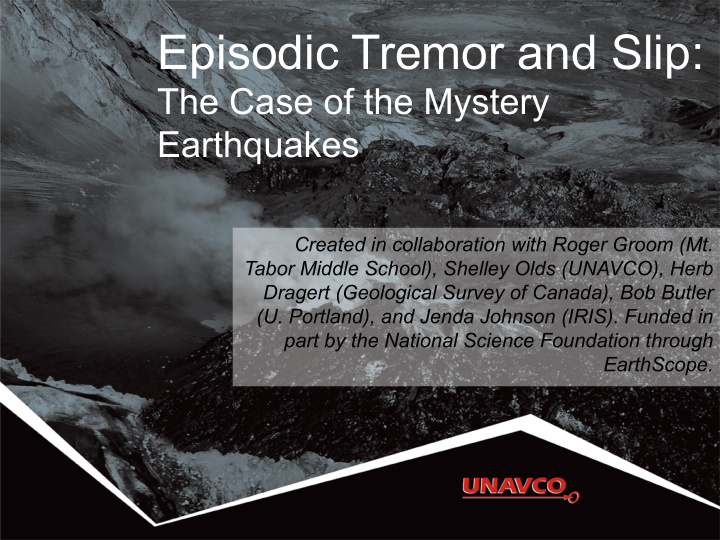



Episodic Tremor and Slip: The Case of the Mystery Earthquakes Created in collaboration with Roger Groom (Mt. Tabor Middle School), Shelley Olds (UNAVCO), Herb Dragert (Geological Survey of Canada), Bob Butler (U. Portland), and Jenda Johnson (IRIS). Funded in part by the National Science Foundation through EarthScope.
Cascadia The Cascadia Subduction Zone Pacific Plate Juan de Fuca North Plate American Plate
Cascadia The Cascadia Subduction Zone Pacific Plate
Tectonics of Cascadia
Tectonics of Cascadia
Hmm . . . What’s happening here? Seismic data from northern Cascadia
Hmm . . . What’s happening here?
Hmm . . . What’s happening here? The mystery begins---strange tremors … no ground shaking … 8
Hmm . . . What’s happening here? • Seismologists couldn’t explain the data. • Instrument problems? • Background noise: Ø Herd of cattle walking near the instruments? Ø Wind? Ø Human-made vibrations like cars or trains? Ø Aliens?
GPS in Cascadia Neah Bay Pacific Beach Tumwater Othello Kelso Tillamook Wasco La Grande Newport Corvallis
What was that?? B
GPS time series plots … … the change in the GPS position over time Y-axis: Ø North Ø East Red Ø He ight (Vertical) points: rapid estimates X-axis: date of measurement
Which way are we going? Is the GPS station North (mm) moving Ø north or south? East (mm) Ø east or west? Ø up or down? Height (mm) Time
Which way are we going? Is the GPS station North (mm) moving Ø north or south? East (mm) Ø east or west? Ø up or down? Height (mm) Time
Gaps in data Causes: • power outages; • snow coverage; • equipment failure; • vandalism; • wildlife; or • aliens again?
What was that?? What happens where Jan 1994 the green line breaks?
What was that?? Oct 1 – Oct 15, 1994 motion measures ~2 mm south ~6 mm west Why?
A pattern emerges . . . Answer questions 5 - 7 on your worksheet. 5 - 6 mm ~ 14 months
A pattern emerges . . . • The technology of GPS measurement advanced dramatically. • Continuous GPS stations were installed. • The pattern was seen again … and again. … • Large areas experienced tremors at about the same time, and tremors repeated every so often. • In 1999, Herb Dragert from the Geological Survey of Canada confirmed this strange reversing pattern in the continuous data from more GPS stations.
Putting the pieces together
Putting the pieces together
Putting the pieces together
Implications What have we learned? Slow slip tremors (slow earthquakes) last 6 -14 days every ~14 months; Equivalent of Mw = 6.7 earthquake; and “Episodic Tremor and Slip” or “ETS.”
Does ETS occur everywhere? ALBH Washington This is this PABH what’s Oregon happened expected, during the but … same time. So what’s happening????
Does ETS occur everywhere? 25
Implications ALBH Washington PABH PABH Oregon
Modeling Noodles!
Modeling 1. Fill a beaker with hot water. 2. Take a piece of lasagna noodle and submerge it partway into the beaker of hot water, like this: 3. Wait about five minutes and then take the noodle out of the water. 4. Answer questions 11 – 14 on your worksheet.
Implications • The Juan de Fuca Plate becomes hotter (around 400 - 500 ° C) as it gets deeper. • The plate becomes more ductile as it subducts. • Slip occurs along the boundary between the Juan de Fuca Plate and the North American plate. • Shallower areas are cooler and brittle. • But, there has not been any recent “breaking” along the coast.
Putting the pieces together Putting the pieces together
Why ETS matters Predict what stations C and D would show on east time series plots. Hint: think about locked vs. slip zones . . .
Why ETS matters Station C would move steadily northeast, while Station D would show a slow slip event. How close were your predictions??
Why ETS matters If slow earthquakes are relieving strain in the “slip” zone, what’s happening in the locked zone? Strain relieved in the slip zone is transferred to the locked zone! The locked zone is getting strained from both sides!
Visualizing--cartoons 34
Visualizing--cartoons The Juan de Fuca plate Strain relieved by the is moving eastward from slow earthquakes is the mid-ocean ridge. transferred westward. Locked Zone Think again of the lasagna experiment … .
Visualizing--analogies Sumatra-Andaman earthquake, 2004
Visualizing--graphics
Quantifying • During ETS events, the transition zone of the deep plate slides 2 - 4 cm/yr to the southwest. • Strain accumulates across the locked zone. • The locked zone prevents relative plate motion; a “slip-deficit” builds up for the locked zone. • In 500 years, how much “slip deficit” would build up on the locked portion of the plate interface? (Use 3 cm/yr.)
Why ETS matters: earthquakes • What did you get? Ø 1500 centimeters slip deficit • If the locked zone breaks, the ground will snap to the southwest 1500 centimeters, or 15 meters!
Why ETS matters: people More than 6.7 million people live in western Washington and Oregon … Who among your friends or family is there?
Tsunami of 1700 Geological Survey of Canada
Why ETS matters: tsunamis If another great earthquake were to occur near the coast of Cascadia …
Why ETS matters: tsunamis Land along the coast would subside, and a tsunami would inundate coastal regions hundreds of meters inland--impacting many, many lives.
Questions Contact: Shelley Olds ece@unavco.org http://www.unavco.org/ Follow UNAVCO on facebook Facebook Twitter
Animations • UNAVCO animations of ETS Ø http://www.unavco.org/cws/pbonucleus/ draftresources/ETSmystery/ETSanimations/ • Animations on slides 4, 22, and 30 by Jenda Johnson, IRIS
Other tools to explore • UNAVCO GPS, Earthquake, Volcano Viewer Ø http://geon.unavco.org/unavco/GEV.php • IRIS Earthquake Browser Ø http://www.iris.washington.edu/servlet/ eventserver/map.do 46
Recommend
More recommend